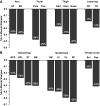Human skeletal muscle-specific atrophy with aging: a comprehensive review
- PMID: 36825643
- PMCID: PMC10069966
- DOI: 10.1152/japplphysiol.00768.2022
Human skeletal muscle-specific atrophy with aging: a comprehensive review
Abstract
Age-related skeletal muscle atrophy appears to be a muscle group-specific process, yet only a few specific muscles have been investigated and our understanding in this area is limited. This review provides a comprehensive summary of the available information on age-related skeletal muscle atrophy in a muscle-specific manner, nearly half of which comes from the quadriceps. Decline in muscle-specific size over ∼50 yr of aging was determined from 47 cross-sectional studies of 982 young (∼25 yr) and 1,003 old (∼75 yr) individuals and nine muscle groups: elbow extensors (-20%, -0.39%/yr), elbow flexors (-19%, -0.38%/yr), paraspinals (-24%, -0.47%/yr), psoas (-29%, -0.58%/yr), hip adductors (-13%, -0.27%/yr), hamstrings (-19%, -0.39%/yr), quadriceps (-27%, -0.53%/yr), dorsiflexors (-9%, -0.19%/yr), and triceps surae (-14%, -0.28%/yr). Muscle-specific atrophy rate was also determined for each of the subcomponent muscles in the hamstrings, quadriceps, and triceps surae. Of all the muscles included in this review, there was more than a fivefold difference between the least (-6%, -0.13%/yr, soleus) to the most (-33%, -0.66%/yr, rectus femoris) atrophying muscles. Muscle activity level, muscle fiber type, sex, and timeline of the aging process all appeared to have some influence on muscle-specific atrophy. Given the large range of muscle-specific atrophy and the large number of muscles that have not been investigated, more muscle-specific information could expand our understanding of functional deficits that develop with aging and help guide muscle-specific interventions to improve the quality of life of aging women and men.
Keywords: aging; sarcopenia; skeletal muscle mass.
Conflict of interest statement
No conflicts of interest, financial or otherwise, are declared by the authors.
Figures



References
Publication types
MeSH terms
Grants and funding
LinkOut - more resources
Full Text Sources

